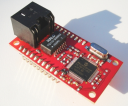This is an old revision of the document!
Table of Contents
The IO project
Like described in the Service packages and licenses article the version decomposes into the variants IO_base and IO_pro.
Common features
- Different IP access modes (DHCP, AutoIP etc.), look at network settings
- Multilingual (German, English, Spanish and Netherlands) webserver for diverse settings.
- Multicast DNS functionality for easy and quick access via the network
- The serial server (net socket) with standard interfaces SPI Master, I2C Master and UART
- Configuring, writing and reading Netzer GPIOs via web interface
- Automatic refresh of the GPIO page within configurable time
- Support of advanced IO peripherals like ADC, PWM, impulse generator und edge counters (look at Netzer GPIO)
IO_base
- Writing and reading Netzer GPIOs via GPIO server
- Select the language of the web interface dynamically
IO_pro
- Select the language of the web interface statically - each language has a separate image
- SNTP client with an integrated real time clock
- Configuring, writing and reading of the Netzer GPIOs via command interface with the connected channels:
- process module for processing ladder logic with a minimum cycle time of 1 millisecond
- Extending the serial server with a I2C monitor
- All pins can be accessed via a new SPI-Master protocol. This new feature can also be ussed to adress more than one slave.
- Asynchron serial interface (UART) interface has new features like parity and handshake signals
- Extending the serial server with TCP Client functionality and DNS resolver
The factory settings
- All Netzer GPIOs are configured as digital inputs.
- The GPIO server resp. command server is listening at port 65000.
- Authentification at command server is enabled
- Automatic reloading of the GPIO web page is disabled
- The serial server is configured for port 64000.
- The serial mode is deactivated.
- UART is configured for 19200 Baud, no parity, no handshake.
- SPI is configured for 10,4 MHz, mode 0, sample at the middle.
- I2C is configured for 100 kHz



